Publication 102 - Wisconsin Tax Treatment Of Tax-Option (S) Corporations And Their Shareholders Page 16
ADVERTISEMENT
Publication 102
corporation ends, or in the final taxable year if the share-
operations. The corporation’s sole shareholder is Bob Jones, a
nonresident of Wisconsin who files his Wisconsin income tax
holder dies before the end of the corporation’s taxable year.
returns on a calendar-year basis. Bob will report $1,800 of
ordinary income (50% x $3,600) and $250 of municipal bond
Example 1: John Smith files his Wisconsin income tax returns on
interest (50% x $500) on his 1997 Wisconsin return. For
a calendar-year basis. He is one of two equal shareholders of a tax-
estimated tax purposes, his entire share of the corporate income
option (S) corporation whose taxable year ends on July 31, 1997.
is considered to be received on December 31, 1997. Therefore,
The corporation’s ordinary income for Wisconsin purposes for the
Bob must take this income into account when determining his
July 31, 1997, year is $5,000. John will include his one-half share
estimated tax payment due January 16, 1998.
($2,500) of such income in his Wisconsin adjusted gross income
for the 1997 calendar year.
2. Taxable distributions from the corporation: on the day of
receipt.
Example 2: Assume the same facts as in Example 1, except that the
corporation’s taxable year ends on January 31, 1998. John will
include $2,500 in his 1998 calendar-year Wisconsin income.
If a corporation makes a distribution before the end of its
taxable year, it may not be possible to determine on the
Example 3: Mary Brown, a calendar-year taxpayer, is one of three
day of receipt whether it is solely a nontaxable distribu-
equal shareholders of a calendar-year tax-option (S) corporation on
tion of prior or current year net income or whether it is
January 1, 1997. She dies on August 1, 1997. The corporation’s
partially a taxable distribution. If, at the end of the
ordinary income for Wisconsin purposes for the 1997 calendar year
corporation’s taxable year, part or all of the distribution
is $6,000. Assuming the corporation doesn’t make a section
is determined to be taxable, it is considered taxable on
1377(a)(2) election, Mary’s personal representative will include
the day of receipt. However, for the purpose of making
$1,162 (212/365 x $2,000) of such income on her final return and
estimated tax payments, income from a distribution is
$838 on her estate’s income tax return for the year including
considered to be received on the last day of the corpora-
December 31, 1997, assuming the estate held all of her stock for the
tion’s taxable year if the taxability of the distribution
intervening period.
can’t be determined before the end of the corporation’s
taxable year.
B. Making Estimated Tax Payments
For the purpose of making estimated tax payments, tax-
O
IX. SHAREHOLDERS’ WISCONSIN INCOME
option (S) corporation income is considered to be received
TAX RETURNS
by shareholders as follows:
The Wisconsin income of individuals, estates, and trusts is
1. Tax-option (S) corporation income, loss, and deductions:
based upon their federal adjusted gross income. This federal
throughout the corporation’s taxable year.
income is then increased or decreased for specific items
(called “modifications”) which are treated differently on the
However, if a tax-option (S) corporation does business
Wisconsin return than federally.
in and outside Wisconsin so that its Wisconsin income
must be computed under apportionment or separate
For taxable years before 1979, all Subchapter S income or
accounting, its nonresident shareholders can’t determine
loss included in a person’s federal adjusted gross income was
the amount of the corporation’s income, loss, and
eliminated through a modification on the person’s Wisconsin
deductions attributable to Wisconsin until the corpora-
return. Only actual dividends received were included in
tion’s taxable year is complete. The nonresident share-
Wisconsin income. The elimination of Subchapter S income
holder must report his or her share of the corporation’s
or loss and the inclusion of dividend income were required
Wisconsin income, loss, and deductions in the share-
“modifications” under the Wisconsin Statutes then in effect.
holder’s taxable year in which the corporation’s taxable
year ends. For estimated tax purposes, the nonresident
shareholder’s entire share of corporate income is consid-
Effective with the 1979 taxable year, the statutes requiring
these modifications were repealed. Therefore, tax-option (S)
ered to be received on the last day of the corporation’s
corporation income, loss, and deductions, adjusted for
taxable year.
Wisconsin purposes, must be reflected in a shareholder’s
Wisconsin taxable income for 1979 and thereafter.
Example: A tax-option (S) corporation’s taxable year ends on
December 31, 1997. Its federal S income (all ordinary income)
for that year is $3,500. For Wisconsin purposes, it has $3,600
Exception: If a corporation which is a federal S corporation
of ordinary income and $500 of municipal bond interest. The
elects not to be a Wisconsin tax-option corporation for 1987
corporation derives one-half of its income from Wisconsin
or subsequent taxable years, modifications similar to those
14
ADVERTISEMENT
0 votes
Related Articles
Related forms
Related Categories
Parent category: Financial
 1
1 2
2 3
3 4
4 5
5 6
6 7
7 8
8 9
9 10
10 11
11 12
12 13
13 14
14 15
15 16
16 17
17 18
18 19
19 20
20 21
21 22
22 23
23 24
24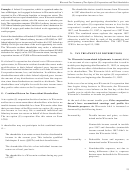 25
25 26
26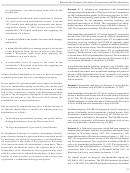 27
27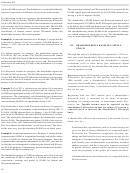 28
28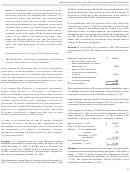 29
29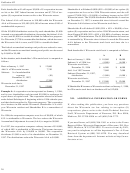 30
30








